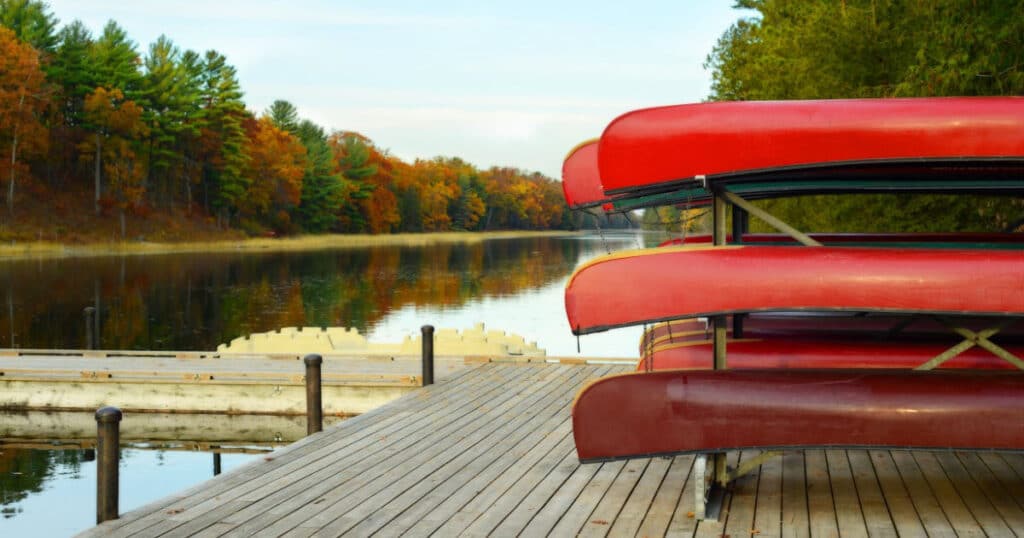After a fun day of canoeing, your smile may dim when you get home and realize it’s time to store your watercraft! Before you give up and carelessly toss it in the garage, explore the great canoe storage ideas I’ll go over today.
From DIY storage to professionally installed options, there are many options for conveniently and safely storing your canoe.
I will explore 15 fantastic storage ideas with tips that hopefully get you excited about storing canoes.
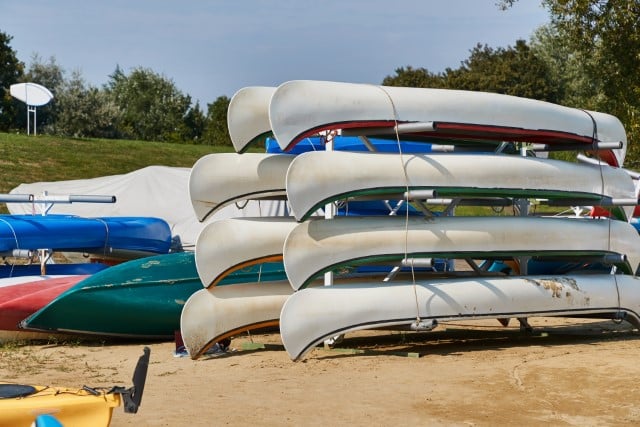
But first, I’ll talk about the advantages of proper canoe storage.
Benefits Of Organized Canoe Storage
Here are the benefits of keeping your canoe safe and secure with the right storage techniques.
Maximized Space
Canoes can take up a lot of space in your garage, driveway, or attic. A dedicated storage space frees up valuable space for other items and activities.
Aesthetics
Canoe storage is a functional display piece that adds character to your space.
Security
Proper storage means deterring potential thieves and, thus, peace of mind.
Easy Accessibility
If you store your canoe properly, you can access it easily, especially for random spontaneous adventures.
Preventing Damage
Storing your canoe in a well-designed space keeps your canoe out of harm’s way. You won’t risk it getting damaged and having to dig into your pockets for expensive repairs (or maybe even a replacement canoe).
Better Lifespan
Protecting your canoe from elements such as moisture and sunlight helps to maximize its lifespan.
Organizing Accessories
Naturally, where you keep your canoe is where you keep its accessories. So, you can locate accessories such as paddles and life vests easily by keeping your canoe in a designated storage space.
Outdoor Canoe Storage Ideas
Some canoeists assume they can just leave their canoes outdoors, but this is usually a bad idea.
Remember, you’ve got to protect your canoe from the elements. This includes sunlight, harsh weather, and falling branches.
Instead of just leaving your canoe outside or throwing it in the garage, think about using one of my 15 favorite canoe storage ideas. Keep scrolling to discover them.
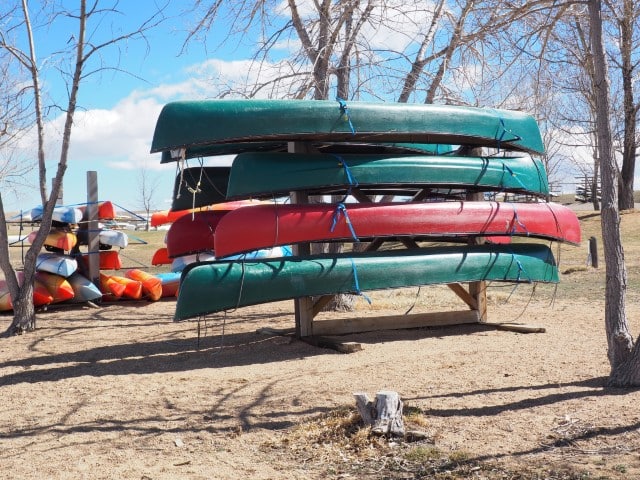
1. Canoe Shed
A canoe shed keeps your canoe protected from the elements and thieves.
It can accommodate your canoe and accessories. Depending on its size, you may also be able to fit other watercrafts in there, like kayaks and paddleboards.
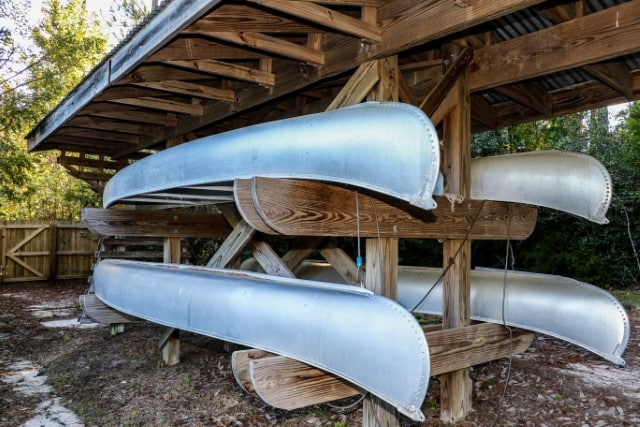
How to Build a Canoe Shed
Do you want to build your own canoe shed? Learn how to do so below.
Think About How Many Canoes You Need to Store
First, decide on how many canoes you will need to store. If you just need to store one canoe, you can probably use a relatively small canoe shed.
Also, think about the kind of canoe design that would be most suitable for your property.
Check online for canoe shed designs and consider which one would be best for you.
Use the Right Materials
In most cases, you will need pressure-treated lumber, a sliding miter saw, a drill, wood stain, sandpaper, tape measure, screws, hinges, and varnish.
Choose a Level Location
Ensure your location is level before you lay the bottom frame. If you place the shed in the grassy parts of the yard, you can dig holes for the legs to ensure stability.
Cut the Wood to Fit
Cut the wood pieces to fit the measured frame, then assemble the side pieces matching the frame and ensuring they hold firmly.
Measure and cut the door and attach it with hinges and screws. You should include a lock on the door to ensure security.
Include a Roof or Protective Shield
Next, you must include a roof or protective shield for the top. You can use wood or corrugated iron sheets.
Ensure you angle it away from the storage to direct water away.
Sand and Stain
Finally, sand and stain the shed before applying two layers of wood varnish to protect the shed from water.
2. Under-Deck Storage
Do you have a deck? If so, you may be able to store your canoe underneath it safely and conveniently. For many of us, this under-utilized space that’s protected from the elements is the ideal solution for tucking canoes and other boats when not in use.
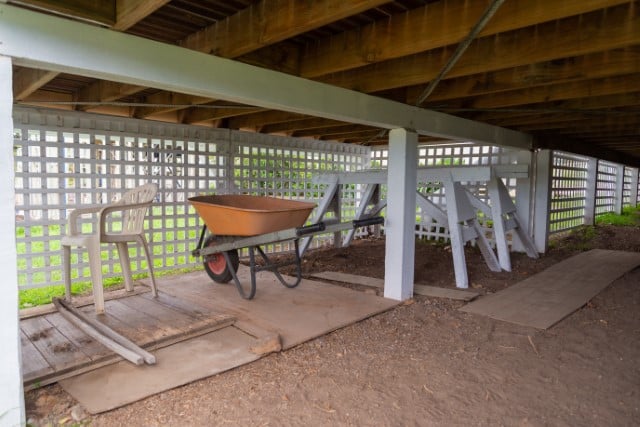
Even better, if your deck is high off the ground, you can create a wood frame to hold your canoe underneath it.
How to Build Under-Deck Storage
Here is how you build under-deck storage for your canoe.
Gather the Materials
Gather pressure-treated wood, sandpaper, and varnish to create a storage frame. Ensure you have tools like a saw, drill, and screws.
Measure Your Canoe
Next, measure your canoe and mark the points under the deck to build a frame.
Measure the canoe’s height to ensure ample space between the deck’s top and the ground
Cut the Wood
Then, cut the wood into the correct measurements and attach them to the deck’s side beams with a drill.
You can make a frame using two to four pieces, depending on the size of your canoe and deck.
Sand and Varnish
Finally, sand and apply varnish to the frames.
3. Lean-To-Shed
As the name suggests, a lean-to-shed attaches to an existing structure, such as the fence or side of the house. These are great for storing everything from firewood, to gardening tools, to canoes and other boats and boating gear.
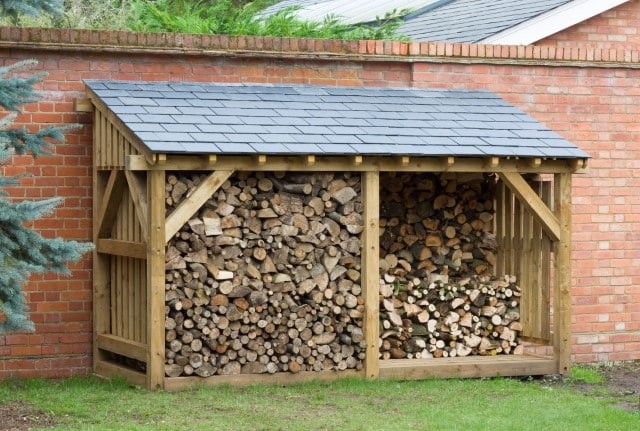
The front side of the shed remains open, and it has a sloped roof to direct water away.
How to Build a Lean-To Shed
Let’s discover how to build a lean-to shed for your canoe.
Find the Right Location
Select a suitable location on the fence or side of the house. Measure your canoe and determine the correct dimensions of the shed.
Decide if You Want a Foundation
You don’t need to create a foundation, but if you do, ensure it is level and stable. You can use post anchors or concrete footing.
Gather Your Materials
Get pressure-treated lumber, roofing materials, plywood, screws, a drill, a saw, sandpaper, and varnish.
Build the Back Frame
Build the back frame by cutting the wood and attaching them using vertical studs. You can attach horizontal and bottom plates to connect the studs.
Attach the Back Frame to the Wall
Then, attach the back frame to the wall or fence using screws and a drill.
Measure and Cut the Wood
Measure and cut the wood pieces to create roof rafters. Then, attach the rafters to the top plate of the back frame.
Attach Plywood to the Back Frame
You can apply plywood onto the back frame and the roof rafters using screws.
Build a Front Frame
Build a front frame with supports using the same measurements and materials as you did the back frame and attach it to the structure.
Install the Roofing Material
Install the roofing material, then sand and paint or apply varnish. Test out the structure and make adjustments where needed.
4. Wall Mounts
With an outdoor wall mount, you can store your store on the exterior of a shed, garage, or another outdoor structure.
An outdoor wall mount will keep your canoe off the ground and protect it from moisture and damage.
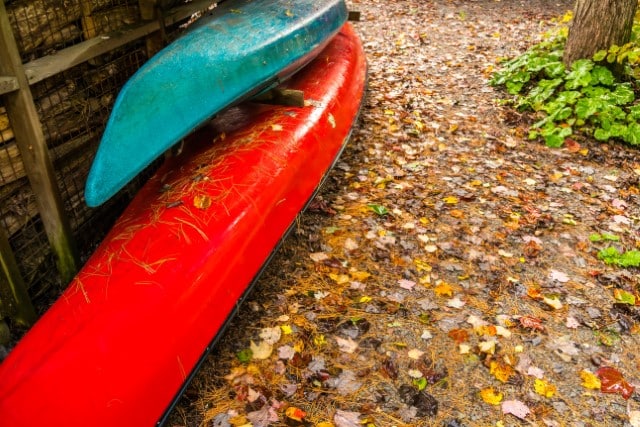
How To Set Up Wall Mounts
But how do you set up a wall mount? You’ll learn all about that below.
Purchase a Canoe Wall Mount
Begin by purchasing a canoe wall mount. You can find different types available, including wood and metal mounts.
They’re also available in different sizes. Measure your canoe to find out what size wall mount you need.
Make sure you have a drill, stud finder, level, and anchors on hand.
Use a Stud Finder
Once you determine which wall mounts you want to set up, use the stud finder to locate the studs.
They provide the necessary support for the canoe’s weight.
Measure Your Canoe
Go ahead and measure your canoe at its widest point and mark the positions on the wall to determine where the mounts go.
Position the Mount
Then, position the mount aligning it with the markings. If drilling into wood studs, use screws and bolts to secure the bracket.
If you are drilling into concrete, use the right anchors and screws.
Secure the Cradle Arms to the Wall Mounts
Next, secure the cradle arms to the wall mounts. These hold the canoe in place.
Give the final structure a gentle tug to check its stability before placing the canoe.
5. Hanging Straps
Hanging straps store the canoe in suspension. You can attach straps to a tree or ceiling joists for easy access.
Hanging straps also prevent direct contact with the ground, reducing the risk of abrasions.
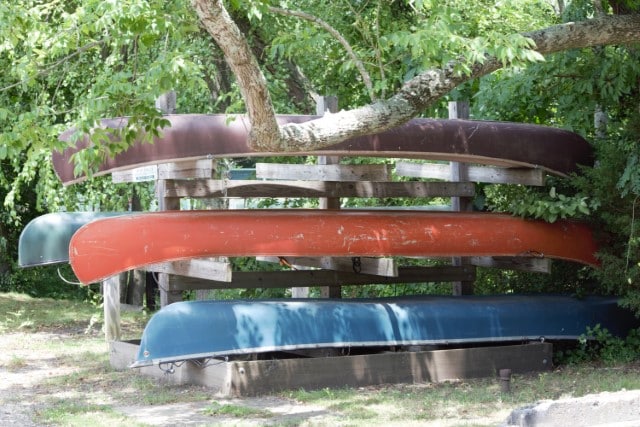
How to Install Hanging Straps
Now it’s time to discover how to install hanging straps for your canoe. Let’s get started!
Decide Where You Want to Install the Straps
Select where you would like to install the straps. It could be under a tree or on the exterior ceiling joists of a garage or shed.
It is best to pick a shaded area to protect the canoe from moisture and sunlight.
Gather Your Materials
Gather your materials, including heavy-duty hooks, nylon straps, drill, anchors if attaching to concrete, measuring tape, and ladder if needed.
Get Your Canoe’s Measurements
It’s time to measure your canoe to get the dimensions and mark them on the overhead structure.
Install the Straps
If you install them on wood, drill pilot holes for the hooks and screw them into place.
If you’re attaching them to concrete, use anchors to secure the hooks.
Cut the Lengths of the Straps
Cut the lengths of the straps and attach them to the hooks using carabiners or secure knots.
6. Canoe Hammock
A canoe hammock is the last but most creative storage method on the list. It requires you to suspend the canoe in a cradle-like hammock, letting the boat hang securely off the ground.
How to Set Up a Canoe Hammock
Here’s how you can set up a canoe hammock on your property.
Gather Your Materials
You will need heavy-duty nylon or polyester webbing, hooks or carabiners, measuring tape, a drill, anchors, and a ladder if needed.
It’s best to get a canoe hammock kit, as they come with specialized straps and cradles.
Find a Sturdy Overhead Structure
Identify a sturdy overhead structure from which you can hang your hammock. This could be ceiling joists.
Measure the canoe’s length and the hammock cradle’s width to help you determine the space needed and the appropriate installation height.
Mark the Points to Secure the Straps or Hooks
Mark the points where you will secure the straps or hooks, ensuring they have even space and are level.
Attach the Hooks or Anchors
Attach the hooks or anchors securely with a drill. Then, attach the webbing to the hooks and gently tug them to ensure they are sturdy.
Position the Canoe Hammock
Position the canoe hammock under the webbing and ensure it is at the center and ready for the canoe.
Indoor Canoe Storage Ideas
Like most of the experts, I think that indoor canoe storage is the best. It gives your watercraft the best protection from the elements.
In addition, indoor storage is an opportunity to be more flexible and creative. If you love DIY, you may even enjoy creating your own indoor canoe storage facilities.
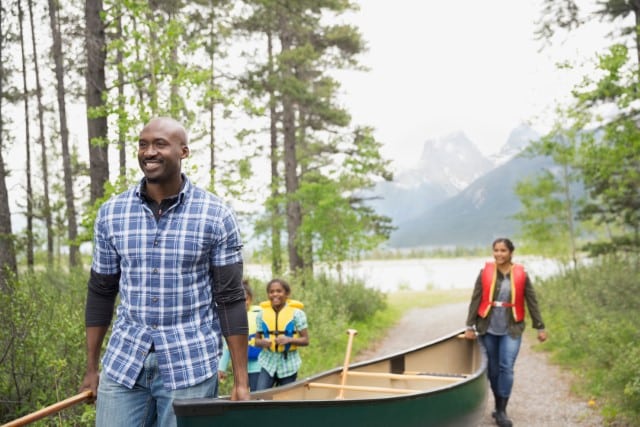
Furthermore, indoor storage means lesser chances of theft which is always a bonus if you live in a high crime rate neighborhood.
Here are some of the best indoor canoe storage ideas:
1. Wall Rack
The wall rack is popular and practical for limited space. It holds the canoe horizontally against the wall and off the ground.
How To Build A Wall Rack
Here is how you build an indoor wall rack for your canoe.
Gather the Right Materials
You will need a canoe wall rack kit, stud finder, level, drill, screws or bolts, anchors if mounting on drywall, and a measuring tape.
Locate the Wall Studs
Locate the wall studs on the chosen wall and mark the points. Measure the length of the canoe and determine the space you need for proper mounting.
Mark the Bracket Points
Mark the bracket points, ensuring they align with the wall studs. Then, install the brackets using screws, bolts, and anchors if needed.
Make Sure the Brackets are Level
Check if the brackets are level before attaching the canoe arms.
Test the Rack’s Stability
Make sure to test the stability of your wall rack before placing your canoe on it.
2. Overhead Suspension
Overhead suspension is great if you have limited floor space in your garage or shed. You can suspend it using ceiling straps, ropes, or a pulley system.
How To Set Up Overhead Suspension
Look below to find out how to set up an overheard suspension system for storing your canoe.
Gather the Right Materials
Gather ceiling hooks or eye bolts, a drill, screws, anchors, and a canoe hoist or pulley system.
Locate the Ceiling Joists or Beams
Locate the ceiling joists or beams using a stud finder where you attach the hooks or eye bolts.
Do Some Measuring
Measure the height of the canoe and the distance between the ceiling and floor for proper clearance.
Mark the Hook or Eye Bolt Locations
Mark the hook or eye bolt locations and install them using screws or bolts depending on the ceiling material.
Install the Pulley System
If you’re going to use a pulley system, install it on the hooks or bolts. After that, use the straps or ropes to attach the canoe to the system.
Hoist the Canoe
Hoist the canoe off the ground and secure it. Test its stability to ensure it has proper balance.
3. Ceiling Rack
A ceiling rack is a unique design and space-saving solution that keeps the canoe out of the way while providing easy access.
If you want to set up a ceiling rack, you will need a canoe ceiling rack kit, stud finder, ceiling hooks, drill, screws or bolts, and anchors.
How to Set Up the Ceiling Rack
I’ll talk about how to set up a ceiling rack below.
Choose an Area and Use a Stud Finder
Identify the area and use a stud finder to find attachment points.
Take Measurements
Now, measure the canoe’s length and the ceiling rack’s width, ensuring proper clearance.
Align Markings with the Rack Width
Align markings with the rack width, then install the hooks or bolts using screws. Use anchors for extra support.
Assemble the Rack Components
Assemble the ceiling rack components, then install them on the hooks or eye bolts. Give the components a gentle tug to ensure they hold well.
Place the Canoe on the Rack
Place the canoe on the rack upside-down and secure it with the straps or locking mechanism.
4. Wall Straps
Wall straps are a flexible version of wall racks. Instead of solid wood or metal, wall straps are nylon or polyester straps you attach to a wall.
You will need strong canoe straps, a stud finder, a drill, anchors, and suitable bolts or screws.
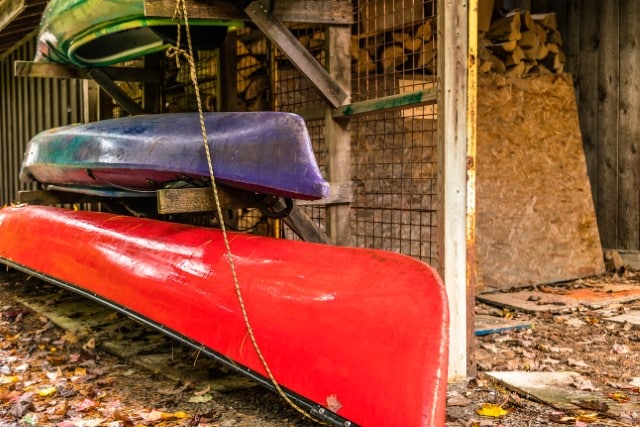
How to Mount Wall Straps
You’ll discover how to mount wall straps below.
Identify the to Use and Find the Studs
After you identify the wall, find the studs and mark them.
Measure the Canoe
Measure the canoe to ensure you have proper clearance.
Mark Where You Will Attach the Straps
Mark where you will attach the straps and align them with the studs and canoe width.
Attach the Straps
Attach the straps using screws, bolts, and anchors for support.
Place the Canoe in the Straps
Place the canoe in the straps horizontally and secure them.
Ensure the boat is at the center and balances well. Tug at the structure to ensure everything holds well.
5. Padded SawHorses
Padded sawhorses are a cost-effective storage method if you have floor space. They ensure your canoe does not touch the ground, helping to protect it.
You will need padded foam or cushioning, measuring tape, and two stable sawhorses. You can alternatively build sawhorses using 2 x 4s.
How to Assemble Padded Sawhorses
Let’s explore how to assemble padded sawhorses.
Measure the Canoe’s Width
Measure the canoe’s width at its widest point to determine the distance between the two sawhorses.
Cut and Shape the Foam or Cushioning
Cut and shape the padded foam or cushioning to fit the top of each sawhorse. Attach the padding on the top of the sawhorses.
You can use velcro strips, adhesive, industrial-strength double-sided tape, fabric glue, staples, or tacks.
Place the Sawhorses Parallel
Place the sawhorses parallel to each other and place the canoe gently on them.
6. Free-Standing Rack
As the name suggests, a free-standing tack does not attach to anything.
Therefore, the rack needs assembly and you’ll have to place it on the ground instead of attaching it to the ceiling or wall mounting.
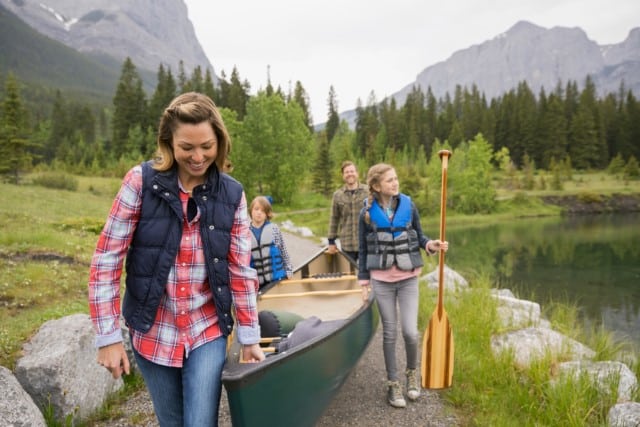
You can purchase a free-standing rack and assemble it. Place it on level ground and ensure the area has shading to prevent damage from sunlight and moisture.
7. Protective Cover Storage
If you have an inflatable canoe, there is no need to worry about things like woodwork, screws, bolts, and sturdiness.
That’s because you can simply store the canoe in its protective cover.
But before you store your canoe, you must clean off any debris and saltwater residue first. Use mild soap and water.
After the canoe dries, deflate it completely. Remove all accessories, and fold the deflated canoe along its original crease.
Place the canoe in its protective cover and store it on a high shelf away from sharp objects, direct sunlight, cold temperatures, and extreme heat. Avoid placing heavy objects on it.
8. PVC Pipe Rack
If you’re handy and don’t mind some DIY, you can create a PVC pipe rack for your canoe.
This option is lightweight and budget-friendly.
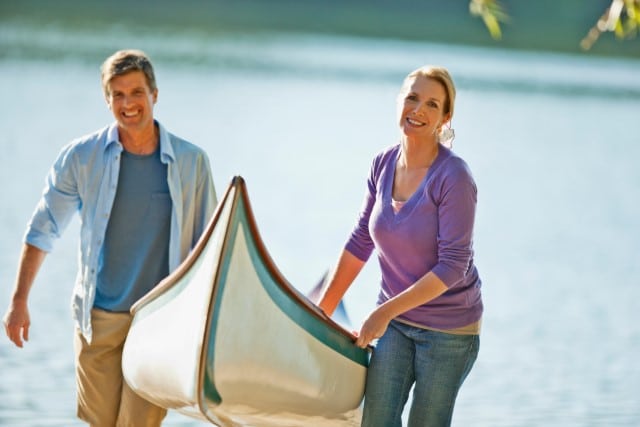
You will need PVC pipes, connectors, glue, a pipe cutter, rubber or foam padding, and measuring tape.
How to Build It
Here’s how to build a PVC pipe rack for your canoe.
Get Accurate Measurements of Your Canoe
You need to measure your canoes to determine the dimensions of the rack. Add a few inches for clearance.
Cut the Pipes
Use a saw or cutter to cut the pipes into the desired lengths.
Assemble the Base
Assemble the base using the pipes and connectors, forming a rectangular or square shape.
Attach the Vertical Pipes
Attach the vertical pipes to each corner of the base using tee connectors.
Add Horizontal Pipes
Join horizontal pipes between the vertical ones to create the support cradles using connectors as needed.
Apply Pipe Glue
Apply pipe glue to the inside of the connectors and insert the pipes to ensure a secure fit.
Add padding
You can add padding using adhesive to cushion the canoe.
Level the Rack and Test It
Level, then test the rack before placing the canoes.
9. Canoe Trolley
Finally, you can use a canoe trolley to store the canoe. But you will need two to ensure the canoe does not tip to one side.
Just assemble the trolleys using the manufacturer’s instructions, then select a flat surface to place them on.

Ensure the surface has enough shading to protect the canoe from sunlight and moisture on either side.
Place foam or rubber padding on the arms or cradles to protect the hull from pressure points. Lift and position the canoe on the arms and center it.
Those Are My Favorite Canoe Storage Ideas
With these amazing ideas, you never have to worry about storing your canoe after a day of fun.
These ideas transform your space while ensuring that your canoe remains free from damage. So, put on your crafting hat and have fun designing!

